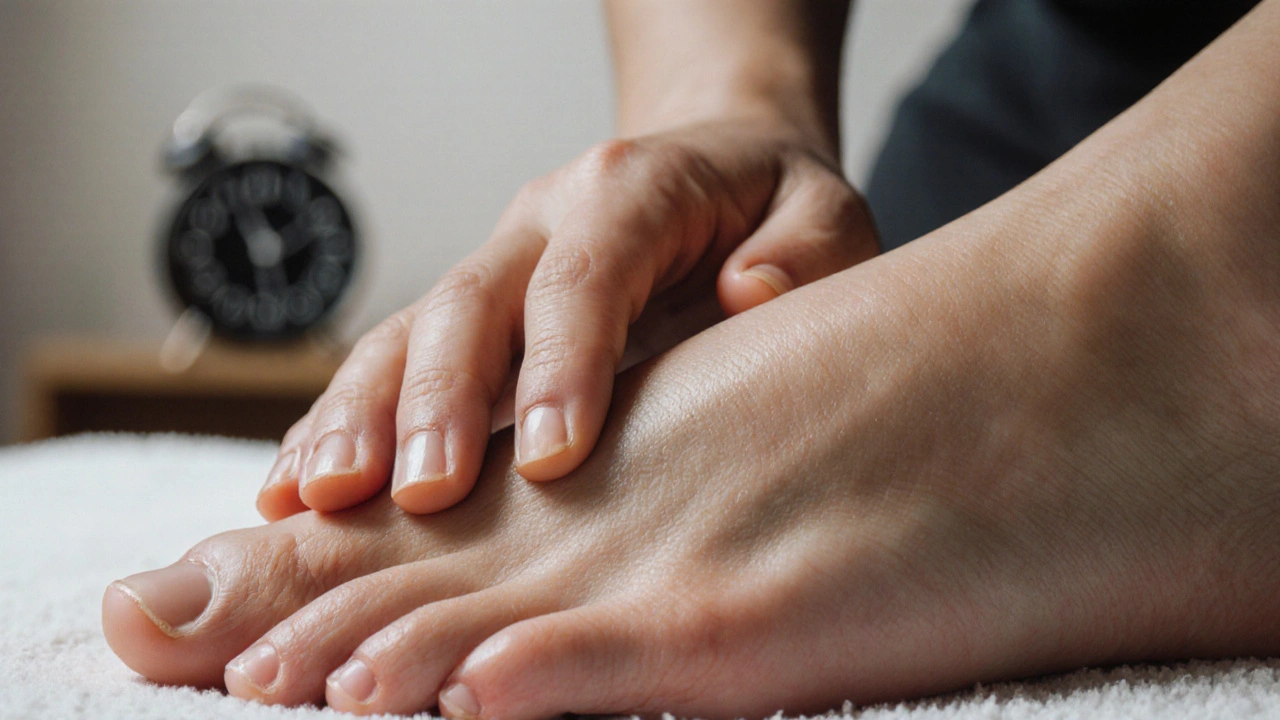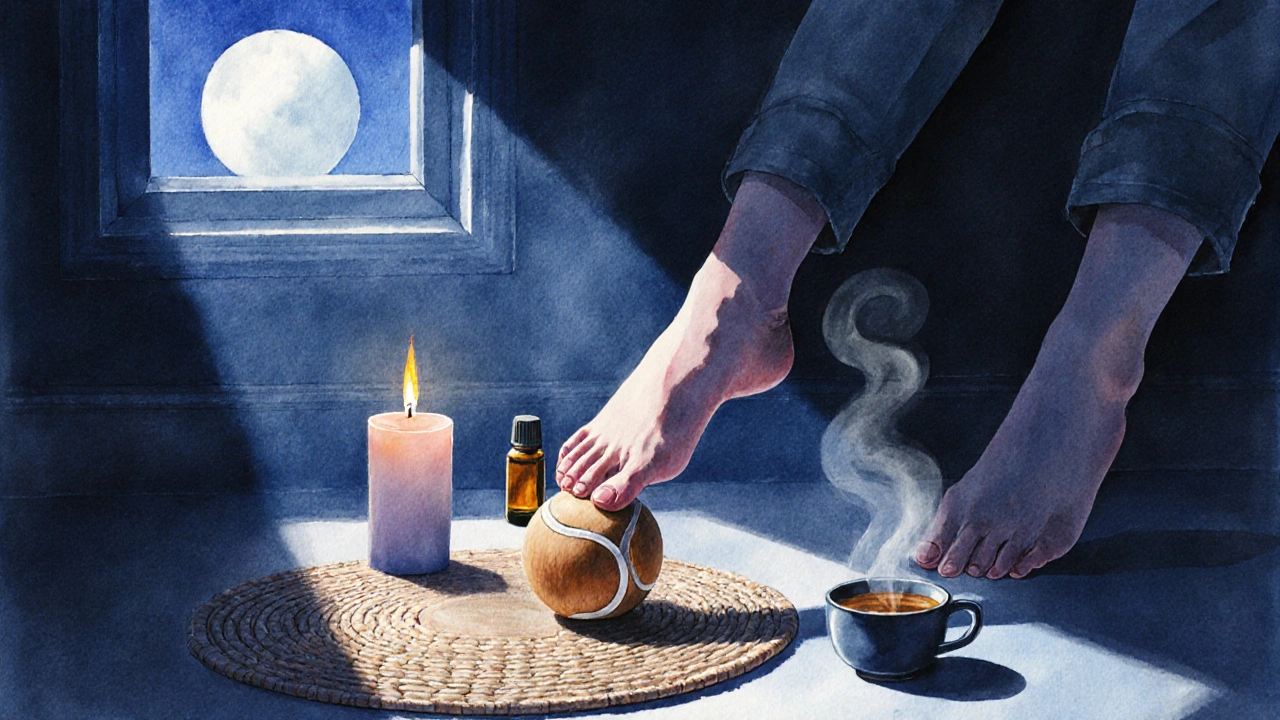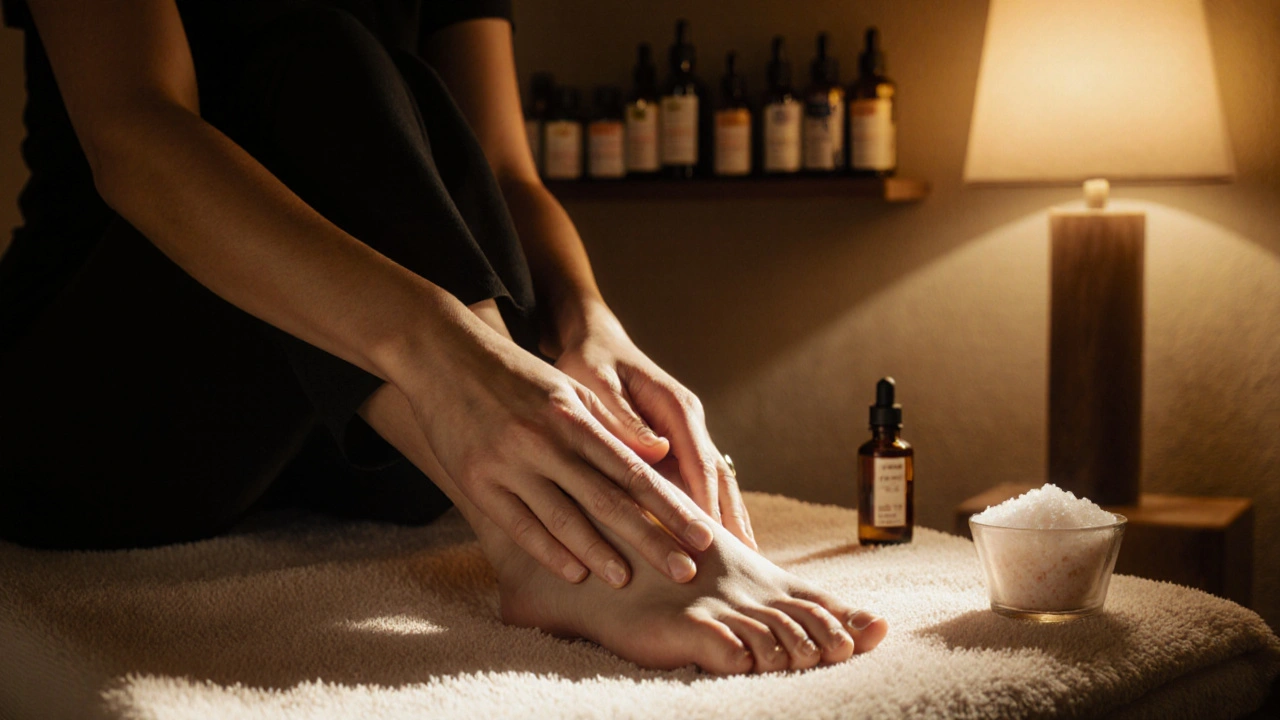Foot massage isn't just about pampering—it's a powerful tool for enhancing overall wellness. It's known to relieve stress, improve circulation, and even boost mood. Learn how this ancient practice can be a simple yet effective way to take care of your health. Whether you're new to it or looking to deepen your understanding, this guide will explore the numerous benefits foot massage offers.

- Created by: Liam Redgate
- Completed on: 31 Oct 2025
- Categories: Foot Massage
You’ve had long days. Your feet have carried you through meetings, errands, kids’ soccer games, and midnight snack runs. They don’t complain. But you? You feel it. That dull ache behind your toes, the tightness in your arches, the way your soles feel like they’ve been stepped on by concrete boots. What if you could reset your whole body with just 15 minutes of focused attention on your feet?
Foot massage isn’t just a luxury you book at a spa. It’s a simple, powerful ritual you can do at home-every single day. And it’s not just about feeling good. It’s about healing, balancing, and reconnecting with your body in a way most people overlook.
Why Your Feet Deserve Daily Attention
Your feet are your foundation. They hold 26 bones, 33 joints, and over 100 tendons, muscles, and ligaments. Every step you take sends pressure through them. Over time, that builds up-tight muscles, compressed nerves, poor circulation. A foot massage doesn’t just soothe soreness. It wakes up your nervous system, improves blood flow, and even helps your digestion.
Studies from the Journal of Alternative and Complementary Medicine show that regular foot massage reduces stress hormones like cortisol by up to 28% in just 10 minutes. That’s not magic. It’s biology. The soles of your feet are packed with nerve endings connected to every major organ. Stimulating them sends calming signals straight to your brain.
Think of your feet like a control panel. Press the right spots, and your whole system responds. No pills. No machines. Just your hands-and maybe a little oil.
What Happens During a Foot Massage?
A good foot massage isn’t just rubbing. It’s a sequence. It starts with gentle warming-light strokes to get the skin and muscles ready. Then comes pressure: thumbs working along the arch, fingers curling around the ball of the foot, knuckles pressing into the heel. You’ll feel spots that hurt just a little-that’s where tension is hiding.
Techniques vary. Some focus on reflexology points-mapped areas tied to organs like the liver, heart, or lungs. Others use deep tissue moves to release knots. And then there’s the stretch: gently pulling each toe, rotating the ankle, flexing the foot. That’s when you start to feel the real shift.
After 15-20 minutes, your feet feel lighter. Your shoulders drop. Your breathing slows. You might even feel a little sleepy. That’s not laziness. That’s your parasympathetic nervous system kicking in-the one responsible for rest and repair.
Types of Foot Massage You Can Try
You don’t need a professional to get results. Here are the most effective styles you can do yourself-or find at a clinic:
- Reflexology: Based on ancient Chinese and Egyptian practices. Each zone on the foot corresponds to a body part. Pressing the inner arch might target the spine; the ball of the foot links to the chest. It’s not about pain-it’s about precision.
- Swedish Foot Massage: Long, flowing strokes with light to medium pressure. Great for relaxation and circulation. Uses oil or lotion to glide smoothly.
- Deep Tissue Foot Massage: Targets knots and chronic tightness. Uses slower, deeper pressure. Best if you’re on your feet all day or have plantar fasciitis.
- Thai Foot Massage: Combines acupressure with gentle stretching. Often done on a mat with the therapist using thumbs and wooden sticks. More intense, but deeply grounding.
- Self-Massage: The easiest to start. Use a tennis ball, foam roller, or even a water bottle. Roll it under your foot for 2-3 minutes each night. Works wonders.
Most people start with self-massage. It’s free, always available, and surprisingly effective.

How to Do a Foot Massage at Home (Step-by-Step)
You don’t need a degree. Just 10 minutes and a little patience.
- Get comfortable. Sit in a chair with your foot resting on a pillow or your lap. Keep your back straight.
- Warm it up. Rub your hands together to generate heat. Then, gently stroke your foot from heel to toes-five times each side.
- Apply oil. Use coconut, almond, or jojoba oil. A few drops reduce friction and nourish dry skin.
- Work the arch. Use your thumb to press in a circular motion along the curve of your arch. Go slow. If it hurts, ease off. That’s your body telling you where to focus.
- Pinch the toes. Gently roll each toe between your thumb and finger. Start at the base, work to the tip. Do this for 30 seconds per toe.
- Press the ball of the foot. Use your knuckle or thumb to press firmly under the ball of your foot. Hold for 5 seconds, release. Repeat 3 times.
- Stretch the heel. Hold your heel with one hand and gently pull your toes toward you. Feel the stretch along the bottom of your foot. Hold for 10 seconds.
- Finish with circles. Use your palm to make slow, clockwise circles over the entire sole. This seals in the relaxation.
Do this every night before bed. In a week, you’ll notice your feet feel softer. In a month, your whole body feels calmer.
What to Expect From a Professional Session
If you’re thinking about booking a session, here’s what usually happens:
- You’ll lie on a massage table or sit in a recliner. No need to undress-just roll up your pants.
- The therapist will ask about any pain, injuries, or health conditions. Be honest. This isn’t just about comfort-it’s safety.
- They’ll use oil, warm towels, or even heated stones. Some places use herbal compresses or salt scrubs first.
- The session lasts 30-60 minutes. Most people feel deeply relaxed, sometimes even a little emotional. That’s normal.
- You’ll be offered water afterward. Your body is flushing out toxins.
Don’t expect a full-body massage. Foot massage is focused. But don’t underestimate it. The ripple effect is real.

Foot Massage vs. Other Relaxation Methods
Is foot massage better than a hot bath? Than meditation? Than a full-body massage? Here’s how it stacks up:
| Method | Time Needed | Cost | Physical Benefits | Emotional Impact |
|---|---|---|---|---|
| Foot Massage | 10-60 min | $0-$80 | Improves circulation, reduces swelling, relieves plantar fasciitis | Calms nervous system, lowers cortisol, promotes sleep |
| Hot Bath | 20-30 min | $0-$5 | Relaxes muscles, eases joint pain | Calming, but short-lived |
| Full-Body Massage | 60-90 min | $70-$150 | Reduces muscle tension everywhere | Deep relaxation, but harder to schedule |
| Meditation | 10-20 min | $0 | Minimal physical effect | Great for mental clarity, less for physical tension |
Foot massage wins on accessibility. You can do it anytime. It’s cheap. It’s effective. And unlike meditation, you don’t have to quiet your mind. Your feet do the work for you.
Who Should Avoid Foot Massage?
Most people benefit. But some should check with a doctor first:
- If you have open sores, infections, or severe swelling in your feet
- If you’re in the first trimester of pregnancy (some reflexology points can trigger contractions)
- If you have blood clots, deep vein thrombosis, or severe diabetes with nerve damage
- If you’ve had recent foot surgery
Otherwise? Go for it. Even if you think you’re too busy, too tired, or too skeptical-try it for five days. You might be surprised.
Make It a Habit
The real power of foot massage isn’t in the session. It’s in the consistency.
Try this: Keep a small bottle of massage oil next to your bed. Every night, after brushing your teeth, spend five minutes massaging one foot. Then switch. No phone. No TV. Just you and your feet.
After a week, you’ll notice your sleep improves. Your morning stiffness fades. You feel more grounded. It’s not a miracle. It’s routine. And routine, done with care, becomes ritual.
Your feet carried you today. Let them rest tomorrow.
Can foot massage help with insomnia?
Yes. Foot massage activates the parasympathetic nervous system, which tells your body it’s safe to relax. Studies show people who do daily foot massage fall asleep faster and sleep more deeply. The pressure on the soles sends calming signals to the brain, lowering stress hormones that keep you awake.
How often should I get a foot massage?
For general wellness, 3-4 times a week is ideal. If you’re on your feet all day or have chronic pain, daily 10-minute sessions work best. Professional sessions once a week are great for deep relief, but daily self-care matters more long-term.
Is reflexology scientifically proven?
Reflexology’s specific organ maps aren’t scientifically proven. But the physical effects-reduced pain, improved circulation, lower stress-are. Whether you believe in energy zones or not, the massage itself triggers real biological responses. Think of it as pressure therapy, not mysticism.
What’s the best oil for foot massage?
Coconut oil is popular for its light texture and natural antimicrobial properties. Sweet almond oil absorbs well and soothes dry skin. Jojoba oil mimics your skin’s natural oils, making it great for sensitive skin. Avoid mineral oil-it clogs pores and offers no nourishment.
Can I use a foot massager instead of my hands?
Yes, but don’t rely on it completely. Electric massagers are great for convenience, especially if you have arthritis or limited hand strength. But your hands offer something machines can’t: intuitive pressure. You can feel where your body needs more or less. Use machines as a supplement, not a replacement.
Learn how foot massage improves blood flow, reduces swelling, and supports heart health. Get tips on techniques, finding London therapists, pricing, safety, and FAQs.
Foot massage is a powerful, science-backed way to reduce stress, improve sleep, and relieve pain. Discover why it's the ultimate relaxation tool and how to get the most out of it in London.




Stuart Ashenbrenner
October 31, 2025 AT 14:55Been doing this for years. No joke, my plantar fasciitis vanished after two weeks of rolling a tennis ball under my foot before bed. No drugs. No PT. Just me, my sockless feet, and a $3 tennis ball from Walmart. People pay $120 for this? I laugh in their faces.
Also, if you think stretching your toes is optional, you’re lying to yourself. Do it. Your future self will thank you.
Raven Ridinger
October 31, 2025 AT 22:15Oh, wonderful. Another ‘healing ritual’ disguised as pseudoscience wrapped in a warm blanket of coconut oil and wishful thinking. Let me guess-next you’ll tell me that rubbing your soles cures cancer? Or that the ‘liver zone’ on your foot is just a ‘metaphor’? Please. Reflexology is not a science-it’s a spa scam with a PowerPoint slide deck.
And why is everyone suddenly obsessed with ‘rituals’? Did we run out of actual medicine? Or did we just decide that if it feels good, it must be medicine? I’m starting to think America’s real epidemic isn’t stress-it’s gullibility.
Also, ‘jojoba oil’? Really? Who talks like this? It’s not a yoga retreat, it’s your foot. Use vaseline. It’s cheaper, and it doesn’t smell like a hippie’s dream.
Timothy Chifamba
October 31, 2025 AT 23:42Man, this is spot on! In Nigeria, we’ve been doing foot massage for generations-grandmas used to rub our feet with shea butter after market days. No fancy oils, no machines. Just hands, warmth, and love.
And yes, it works. My cousin, a motorbike rider in Lagos, used to walk with a limp after 12-hour shifts. Started massaging his feet for 10 minutes every night with coconut oil. Three months later? He’s running marathons on weekends.
Don’t overthink it. Just do it. Even if you’re tired. Even if you think it’s silly. Your feet don’t care about your skepticism-they just want to be held.
And if you’re on your feet all day? Do it twice. Once in the morning to wake them up, once at night to let them rest. Simple. Free. Powerful.
andre maimora
November 1, 2025 AT 09:01Delilah Friedler
November 2, 2025 AT 13:02I’ve been doing this every night for six months now. Started because I had chronic insomnia and thought, ‘what’s the worst that could happen?’
Turns out, nothing. Just better sleep. Less morning stiffness. My wife says I’ve stopped groaning when I get out of bed. I didn’t even know I was groaning.
Used to think it was hippie nonsense. Now I can’t imagine my life without it. I keep a little bottle of almond oil by my bedside. Five minutes. No phone. Just me and my feet. It’s the only time my brain shuts up.
And honestly? If you’re skeptical, try it for five days. Don’t read the science. Don’t argue with the reflexology maps. Just rub your feet. If nothing else, you’ll have softer skin. And isn’t that worth five minutes?
Sloan Leggett
November 2, 2025 AT 20:08Let’s address the elephant in the room: the article misuses the term ‘parasympathetic nervous system’ as if it’s a magic button you press with your thumb. It’s not. It’s a biological cascade influenced by multiple factors, not one 15-minute foot rub.
Also, citing the Journal of Alternative and Complementary Medicine? That’s not peer-reviewed science-it’s the journal that publishes studies where people believe crystals heal water.
And who wrote this? Someone who’s never had plantar fasciitis? The ‘pinch each toe’ step is medically irrelevant. The ‘knuckle press’? That’s just deep tissue massage. Nothing new. Nothing groundbreaking. Just repackaged common sense with buzzwords.
And why is everyone suddenly calling it a ‘ritual’? It’s a massage. Not a sacred ceremony. Stop romanticizing basic self-care. It’s not enlightenment. It’s just your feet not being crushed by shoes all day.
George Granados
November 4, 2025 AT 04:33Just wanted to say this changed my life. I used to think I was too busy to care about my feet. Then I broke my ankle skiing last winter. Rehab was brutal. The PT told me to massage my feet daily. I thought it was a joke.
Turns out, it was the one thing that actually helped. Not the exercises. Not the ice packs. The massage. Five minutes every night. Just me, my foot, and a water bottle.
Now I do it even when I’m not injured. It’s my wind-down. My quiet time. My way of saying thanks to the part of me that carries me through every damn day.
Don’t overcomplicate it. Don’t buy the oils. Don’t watch YouTube tutorials. Just grab something round and roll it under your foot. Do it while you’re watching TV. Do it while you’re on the phone. Do it because you’re alive and your feet deserve to feel good.
You don’t need a reason. You just need to start.